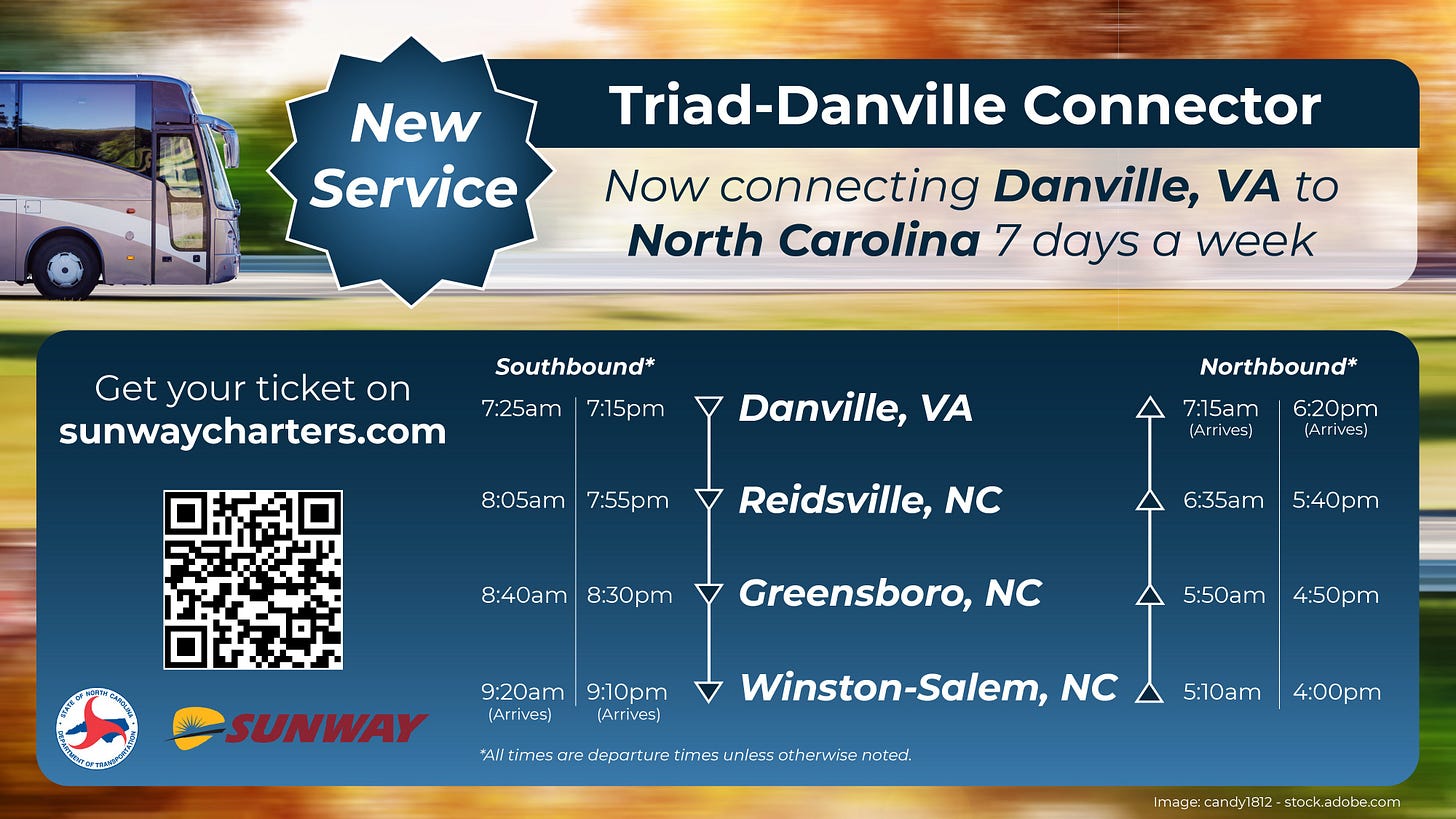North Carolina’s newest intercity bus service
What intercity bus service can achieve for multimodal connectivity in the Tar Heel State
Last month, North Carolinians witnessed the launch of a new intercity charter bus line serving the state’s Piedmont Triad region. Dubbed the ‘Triad-Danville Connector,’ the route runs two bidirectional buses daily from Winston-Salem to Danville, Virginia with intermediate stops in Greensboro and Reidsville. The route’s schedule is lined up with the existing Virginia Breeze intercity bus service that runs between Danville and Washington, DC.
NCDOT contracts with Sunway Charters to provide this service along with three other routes, two of which serve the Triad area:
Mid-State Express: Winston-Salem to Fayetteville via Lexington, High Point, Asheboro, Siler City, Sanford
Mountaineer East-West: Boone to Winston-Salem via Wilkesboro, Hamptonville
Mountaineer North-South: Boone to Charlotte via Lenoir, Hickory, Newton, Lincolnton, Gastonia
Combined with a series of Greyhound routes that cross the state, NCDOT supports a total of 11 intercity routes. However, many these routes run no more than once a day in each direction. Greyhound has also faced severe budget shortfalls in recent years, resulting in their stations relocating to inaccessible areas of many cities and their buses running behind schedule.
North Carolina’s mediocre intercity bus service pales in comparison to its state-sponsored passenger rail service. 2024 was the third straight year NC By Train saw increased ridership, anchored by the Piedmont line running between Charlotte and Raleigh. However, intercity bus presents an immense opportunity for North Carolina communities not yet served by passenger rail such as Winston-Salem, Wilmington, and Asheville.
For one, intercity bus routes are far more flexible and affordable stopgap options for communities not connected by rail. This is dependent on said intercity bus service being reliable, frequent, and relevant to where it’s dropping off. For example, bus service running from downtown Raleigh to downtown Wilmington multiple times a day will substantially boost ridership compared to the location of their current intercity bus stations which are located in unwalkable areas far from their downtown cores.
Intercity bus routes can also complement existing passenger rail service in the state. A good example would be direct and more frequent connection between Winston-Salem and Greensboro that is timed with Amtrak trains to Charlotte, Raleigh, and DC.
Finally, intercity bus service is a cost-effective way to connect populations that may have limited access to personal automobile transportation and are concentrated in specific areas. College students, many of whom cannot afford to buy, maintain, and park their own motor vehicle, could benefit from a frequently running bus connecting them to their hometown or academic/economic opportunities in other cities.
While Appalachian State University in Boone has bus service to Winston-Salem and Charlotte, it’s limited in its frequency. Other schools in more remote areas of the state such as Western Carolina University and East Carolina University could benefit from a more robust intercity bus network. The same could be said for major universities within population centers in the state such as UNC-Chapel Hill, North Carolina State University, or UNC-Charlotte with students living in less populated communities.
One example of robust state-sponsored intercity bus service I’ve observed was the Bustang network in Colorado, which operates three major lines:
North Line: Fort Collins to Denver via Loveland
South Line: Colorado Springs to Denver via Monument
West Line: Grand Junction to Denver via Glenwood Springs
These bus lines run 12-15 buses daily from major cities across Colorado to Denver’s Union Station, home to Denver’s bus, light rail, and commuter rail lines. They accomplish many of the goals of intercity bus service outlined earlier in this post: connecting communities not reached by rail service, connecting communities to existing rail service, and reaching populations who might otherwise have limited to no mobility options.
I had the opportunity to ride the Bustang to and from Fort Collins last year for a conference. The trip was comparable to driving time without the hassle of renting, driving, and parking a car. The ride was also comfortable and affordable, clocking in at $20 round-trip. Funny enough, I spent the whole ride writing for this blog.
North Carolina could benefit immensely from a similar intercity bus network. It could:
Compliment the existing rail service (e.g., ten buses daily from Charlotte to Raleigh via Greensboro);
Connect communities not already served by passenger rail (e.g., five buses daily from Winston-Salem to Raleigh via Greensboro), and;
Connect communities who would benefit most from alternative methods of transportation (e.g., five buses daily from Boone/Appalachian State University to Greensboro via Winston-Salem).





Bustang is reliable enough that I can use it for work, to get to meetings along the West line and back. For those of us that are either not able to drive the I-70 mountain corridor or don't have cars that can hack the winter conditions, it's a gem.
Imagine if the buses, garages and spare parts were owned by the state, and the drivers and mechanics and support staff were state employees with benefits and good pay. Why should we spend taxpayer money to charter a private, for profit company to provide a service that the state could do? Then, the money that goes to profit for the charter company could either be reinvested into the system for more buses and drivers, better stations, more stops, etc, or used to provide good pay and benefits to the employees. Probably enough to do both. But I suppose people might complain that using government money to provide government services while bypassing the for profit private sector is too much like socialism. When in fact it is just effective government.